#someone: hal was boring after parallax
Explore tagged Tumblr posts
Text
Anyway, I think the worst thing Geoff Johns did to Hal's character is that he just made him boring. The fun thing about Hal is that he's the worst man to walk the earth. He's a trainwreck in the making. Every day he wakes up and thinks nothing and makes 20 awful decisions and messes up everything and goes to sleep content in a job well done and it's great. Hal is the Worst Man Ever™. He's a donkey in human form. By all means his personality and skillset makes him the perfect supervillain but he's a hero and he's imperfect and he claws himself back from the brink long after most people would've given up because that's who he is. That's at the core of his character. Even when he's below rock bottom, he never gives up, and god does he hit it, over and over again.
Johns just... erased all that complexity by making Hal the bestest greatest most precious lanterny lantern ever. Suddenly everyone loves him and treats parallax as just a 'hehe! Whoops!' and it sucks because if you take away the fact that Hal is a garbage human being he's just BORING. He's just a boring stereotypical stoic superhero. Who wants to read that! Who wants to read about Universe's Best Most Precious Greatest Man Gets Praised And Solves Every Problem And Is Never Wrong. Like at least when batman does it they try to give us a detective story. Usually it's not a good detective story but they at least try. Hal doesn't need to do detectiving. He can solve pretty much anything with the ring on his finger. He's invulnerable and powerful and perfect and let's be real, at this point he barely has a secret identity. There's nothing adding stakes to the story, not when Hal the best boy is here.
It's so fucking boring!! It's genuinely an injustice to his character. Hal's much more interesting when he makes every single bad decision, ever, and then has to dig himself out of the hole that he dug. That's someone I can root for. That's a character I can develop complex feelings about. If you just hand me the perfect being in creation I feel nothing. I'm already bored.
#in conclusion thank you Jeremy Adams for feeding me. that man is the worst man in existence. i want to put him in the juice presser#like you look at hal and you just know he never replaces his toothbrush#hal jordan#meta#i guess#this is also how i feel about ollie btw#men who are the worst 🤝#im more okay (though still annoyed) by Bruce being the best because the whole point of his stories is that he's so smart he can solve any#mystery. there's other things driving the stakes. plus he's more limited in power so even when he's the Best there's still narrative tension#hal is just too op for something like that to work#and for other characters like superman who are also op they thrive off of a nonpowered supporting cast#but Hal's supporting cast are all other lanterns. or like. superman.#like you don't need to be the Worst Man Alive to carry a narrative through the strength of your personality as Wally demonstrates#but you still need a PERSONALITY#you can't have a personality if you're the best at everything always
88 notes
·
View notes
Note
I keep missing when people post these damn ask games until after their first response. Anyways: O - Choose a song at random, which OTP does it remind you of <- it doesn't have to be an otp, could just be one for a character, I'm just poaching music from people J - Name a fandom you didn’t care/think about until you saw it all over tumblr S - Show us an example of your personal headcanon <- More Lore
[ask game]
hi axel :3
O - Choose a song at random, which OTP does it remind you of <- it doesn't have to be an otp, could just be one for a character, I'm just poaching music from people
my stategy for picking a random song was to pull up the 400 song long spotify playlist i stole from a friend i don't talk to anymore and take the first song it picked on shuffle. anyway it gave me Black Hole by boygenius, which i frankly cannot remember if I've ever heard before in my life.
anyway based on a single listen + a quick scour of the lyrics it gives me jason todd x isabel ardila vibes perhaps. the more interesting version of them that lives in my head.
J - Name a fandom you didn’t care/think about until you saw it all over tumblr
oh this is hard. if i care about something you'll be able to tell because i would simply never shut my mouth about it. i think... team fortress 2, probably? it's the fault of a singular person i follow. not part of the fandom but i do look at the art & headcanons & whatnot with a certain level of fascination. they're endearing and the memes are funny.
a fandom that i'm actively getting into because tumblr made me curious would be all the green lantern lore (idk if this counts because i'm already into other dc stuff but whatever). esp hal's parallax stuff because the fanart i've seen was sick as hell and i got curious. i've been planning to check out kyle for a while but hal jordan and all the other guys are intriguing me in ways i don't think they would have if i wasn't getting that tumblr background radiation.
S - Show us an example of your personal headcanon
for kyle to actually make a living freelancing these days he absolutely has a massive social media presence. internet microcelebrity. his work in the comics seem to mostly be more graphic design adjacent, (like drawing radu's logo,) but given that he's specifically mentioned that he would go to the zoo to practice drawing animals i do think he'd be a furry artist. this is a niche he would find himself falling into. maybe he designs adopts maybe he just draws commissions of people's preexisting ocs, i don't know. but this man does draw anthropomorphic animals.
i don't really know enough about the jla to know who would be on the other side of this interaction. but imagine kyle doodling on a construct notepad while ignoring the debrief batman's giving the jla. and someone recognizes his art style. or in general all his constructs are designed in a way that suspiciously resembles the work of that one guy with 50k twitter followers.
i do not know what his fursona would be but it's probably something boring and generic like a fucking. idk. golden retriever.
5 notes
·
View notes
Text
Did the Parallax retcon let Hal get off scot-free?
So sometimes I’ve been hearing people saying that retconning Hal as being possessed by a yellow space bug takes away from his character development as Parallax, which is fair enough, but did it really erase all responsibility and consequences of his phase as a villain? Long post under the readmore lol
The Significance of Emerald Twilight
First of all, what good things did Hal becoming Parallax bring to the table? What I like about ET is that is showcased how his biggest strength can also be his biggest weakness – how too much willpower can be extremely damaging. After Coast City was destroyed, Hal couldn’t accept it – until then he always felt that with the most powerful weapon in the universe on his side, with enough willpower he could achieve anything. However, that just leads to him being ten times harder on himself when he makes mistakes. There was no way to reverse Coast City’s destruction, but he still tried to will the whole place back into existence, trying to fix what cannot be undone (hold that thought for later).
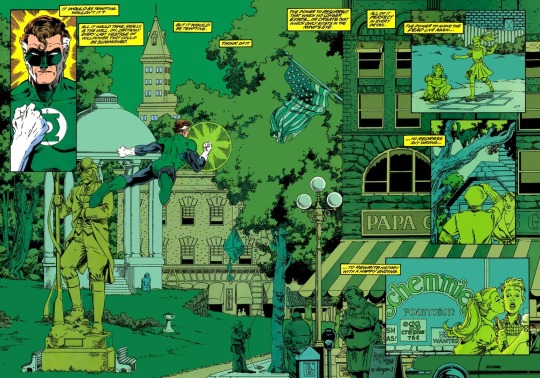
When the Guardians reprimanded him for using the ring for personal gain (which is kinda dumb considering what we’ve seen the rings be used for before), it all came crashing down and he was overcome with grief and fear that he’ll fail again, as well as anger at the Guardians for letting this happen. He became obsessed with becoming as powerful as possible to make things right, so that he’ll never fail again, no matter the cost.
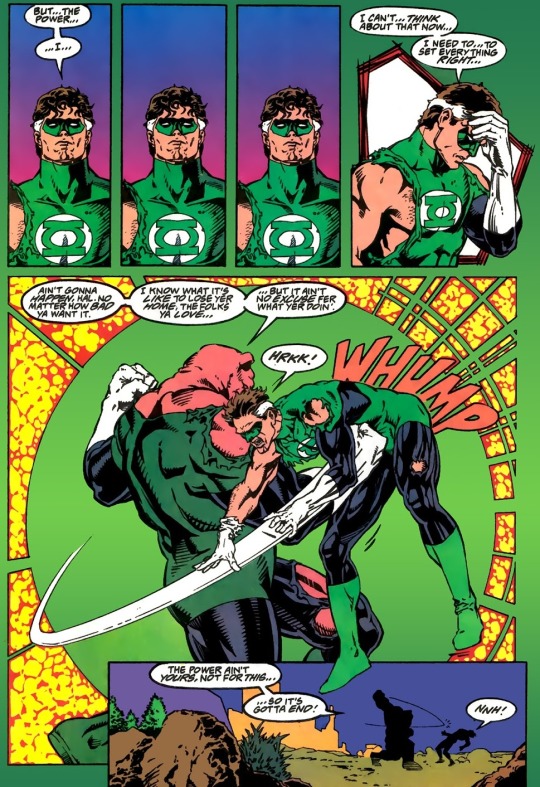
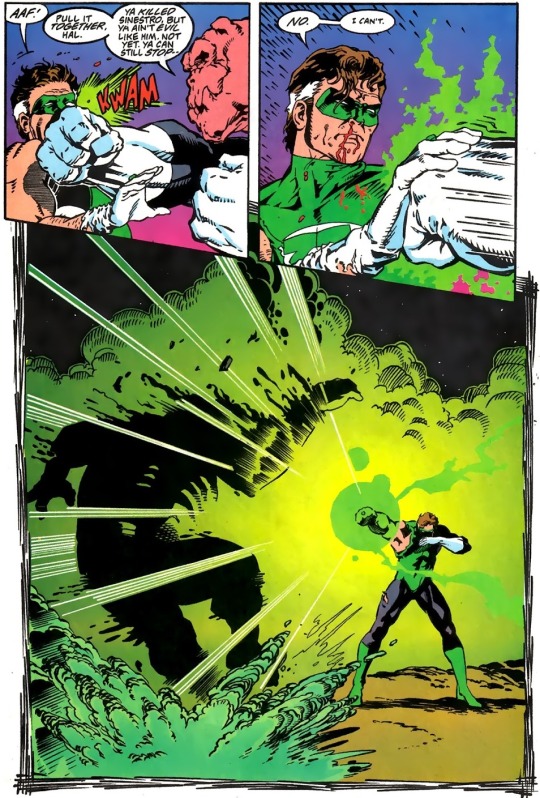
Looking back on it, we could argue that it’s a story with great potential but was rushed and really only came into existence to try and shake up sales through shock factor. It would have been much better if they had previously written more hints towards Hal being burnt out, putting too much pressure on himself, growing disillusioned with the Guardians and questioning whether the GLC has made enough of a difference. Instead it just felt like they wanted to send him off as quick as possible, which feels like a great disservice to the character who was the star of GL comics for so many years. Plus, to be honest I don’t really like how he ended up like a cliché villain in stories like Zero Hour. But hey, that’s just me, and we did get Kyle out of it all. Either way, everything changed when the fire nation attacked GL Rebirth happened.
Was Hal released from all responsibility?
I really like the early Geoff Johns era before all the end-of-the-universe events, because it had these stories about Hal trying to rebuild his life and make up for what he’d done. For a start, Johns didn’t just sweep the whole Parallax thing under the rug as if it never happened; Hal wasn’t completely absolved of the blame and responsibility. It took a while for his fellow Lanterns to accept him again, and for him to make peace with his past.
I think this could have been done better though – Johns made it seem like Parallax had been affecting Hal since way before Emerald Twilight, so any moments of self-doubt or reflection before that weren’t truly him. I guess this was to push forward the confident flyboy persona, but we could have had something like Parallax only being able to affect him once he’d had his breakdown. Still, Hal gets some blame put on him since Parallax managed to get hold of him precisely because he did the one thing a Green Lantern should never do: let fear and anger overwhelm him.
It’s also worth mentioning that unlike Kyle’s possession by Parallax in Sinestro Corps War, Hal seemed to be more in control the whole time. Whether because Parallax decided to lay low to take advantage of the fact Hal didn’t know of his existence, or because Hal’s willpower was that strong, I can’t really imagine a yellow space bug wanting to do some of the things Hal did as Parallax. You could see it as Hal’s fear and anger being entirely his, but Parallax warping them to the point of destroying the corps and turning against all his friends. I’m just saying, we could have had a bit more of a compromise between making him redeemable and keeping some of his development from ET, but oh well.
Either way, Hal claimed responsibility for his actions and it wasn’t an easy journey moving on from that. Step one – getting over the guilt.
The consequences: Character progression post-Parallax

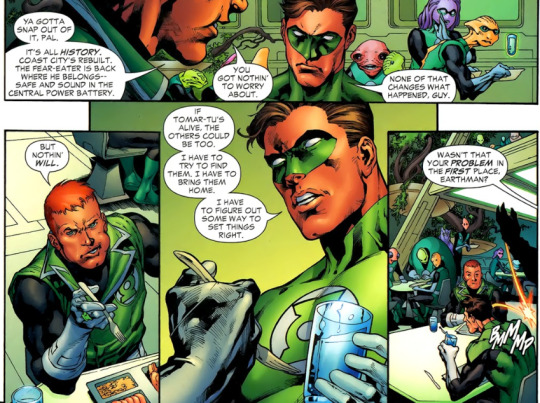
You know it’s rough when Guy Gardner is giving Hal Jordan a pep talk. This is a turning point though, where he’s starting to regain his willpower and use it to try and fix what he’s done. Here, it’s rescuing the Lost Lanterns, who he left for dead as Parallax. Luckily he saves almost all of them from Cyborg Superman, but he isn’t forgiven yet for getting them in that situation in the first place.
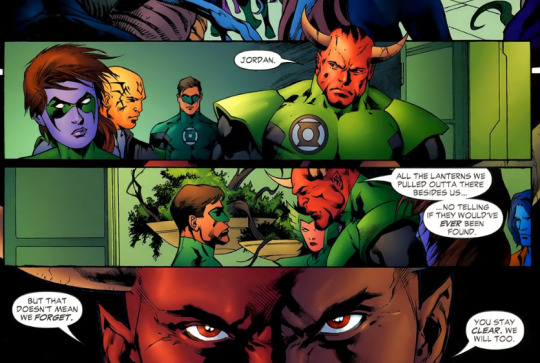
Much like during ET, he’s still trying to fix everything and make things right, but in order to truly move on he’ll need to do what he couldn’t when Coast City got destroyed – accept that not everything can be reversed.
You can see him progressing towards this in his Earth-based stories. In his adventure with Green Arrow, his tangle with Mongul and his Black Mercies ends with him realising how he needs to focus not on what he’s lost, but on the friends and family he still has.
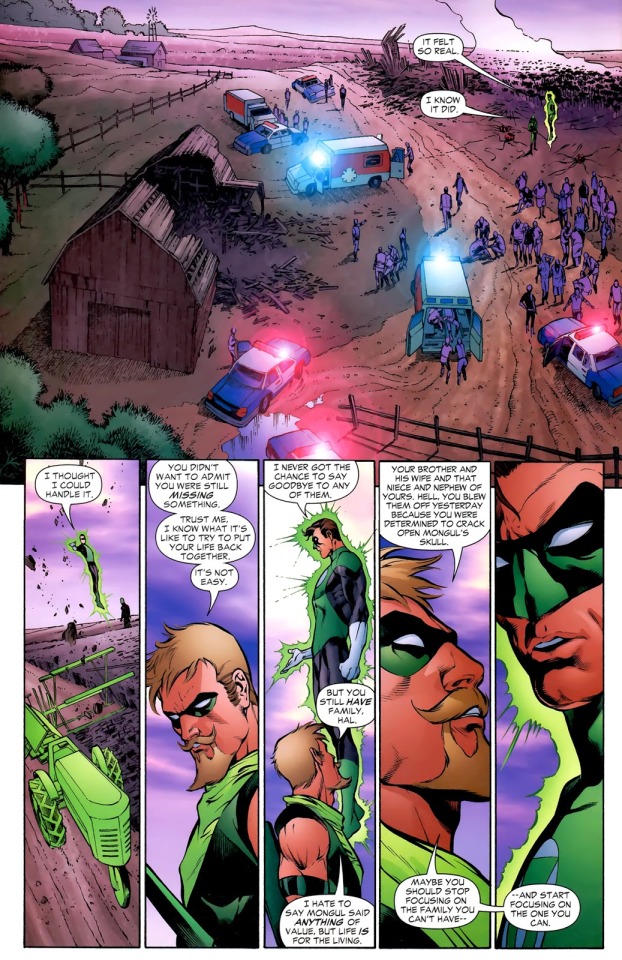
He starts looking to the future – he reconciles with Batman, becoming a hero again in the eyes of the most skeptical, he reconnects with his family and becomes an inspiration to them for overcoming fear. We see him take his life back again, piece by piece.
It’s subtle, but by Blackest Night, he’s regained his willpower again.

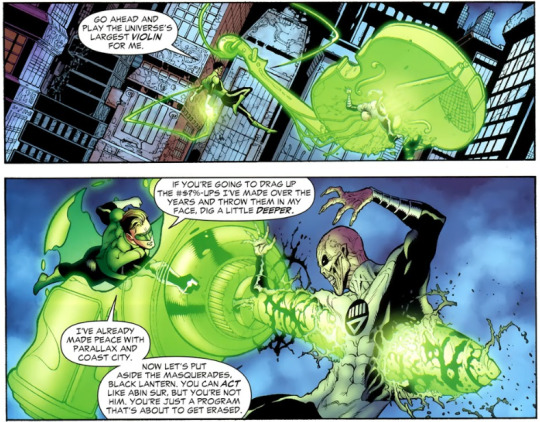
This is actually really refreshing, to see a character who’s been through some shit manage to overcome it and not let others use their past against them. Like what Guy said earlier, he now knows there’s no way to erase his mistakes, so there’s no point in constantly beating himself up over it. All he can do is use his willpower to do more good than bad, and make sure something like Coast City never happens again. It’s honestly inspiring, seeing him fight his way to redemption and come back stronger than before.
His development due to Parallax is not just in how he deals with the aftermath, but also in how he approaches being a Green Lantern at all. Previously, Hal was known intergalactically for being fearless, doing everything he could to live up to his father’s bravery. It wasn’t until Parallax that he truly understood that being a Green Lantern isn’t about ignoring fear, but acknowledging it, and overcoming it. He couldn’t deal with his fears last time and let them overwhelm him, but now he’s learnt to be more in touch with those emotions so no one can use them against him again.
However, there’s still a ways for his character to go.
Future progression
It’s only natural that something like Parallax will have long-term consequences, even if they are more subtle. Hal did well in learning from his experience, but since becoming his willful self again it’s like he takes on too much responsibility. When Earth becomes the setting for Krona to capture the emotional entities, he allies himself with characters like Atrocitus and Larfleeze to look for them, instead of asking the Justice League for help, or at least alerting them on what’s going on. Naturally they weren’t very happy about that.

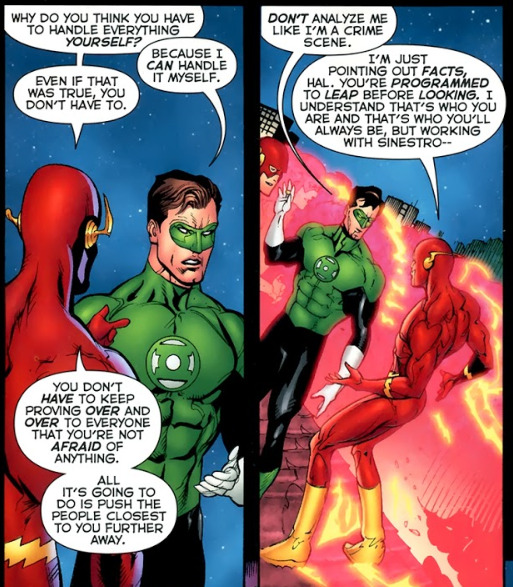
To be fair, it would be the opposite of helpful if someone like Superman got possessed by Parallax, and Barry actually does briefly in the same issue. Still, letting people like Atrocitus and Sinestro roam around when you’re unable to keep an eye on them all the time isn’t the best idea. Having the JL on call would have been helpful, and if they’d been around to help even sooner, they could have helped locate the entities. It’s too late though – Krona shows up with some entities already in tow and Hal gets his butt kicked so bad he ends up on the Watchtower infirmary, but he still won’t accept their help.
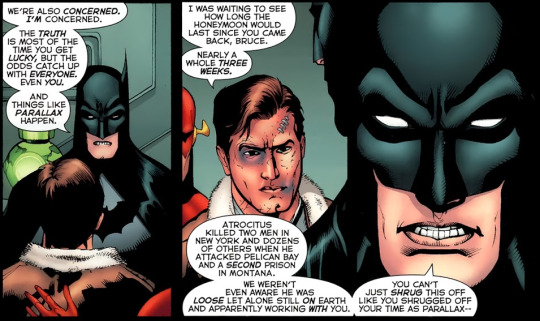
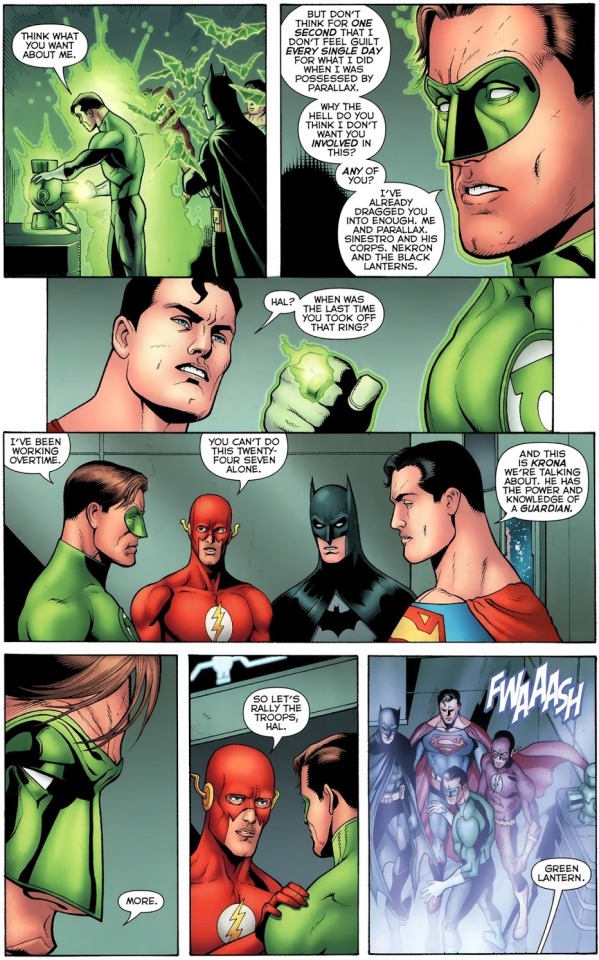
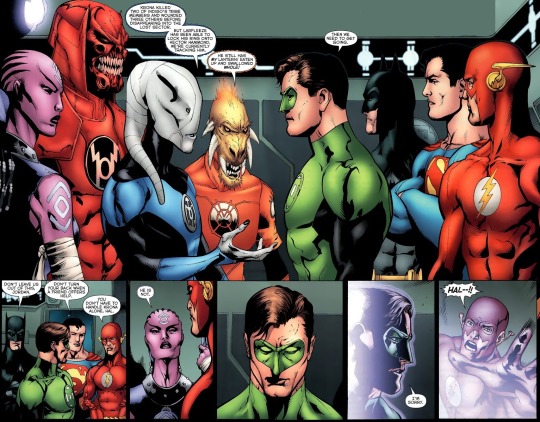
Insisting on flying solo is already a pretty core trait of his, which only gets worse at moments like this. He tries to handle as much as he can on his own so no one else gets hurt because of him again, but all this does is wear him out and push away those who want to help. I kinda wish we could have focused on the consequences of this a bit more so he’d learn something from it, but Johns didn’t really touch on it again before Venditti took over. This theme does actually carry over into his time as corps leader though, but maybe that’s a post for another time – this one is long enough as it is :’P
TL;DR
The Parallax retcon may have made Hal redeemable, but he still had to work for it. Parallax was developed throughout Johns’s run rather than shoved aside and forgotten, and some of the best Green Lantern stories came from this.
#dc#green lantern#hal jordan#parallax#justice league#blackest night#geoff johns#dc meta#green lantern meta#dc comics#this probably made more sense in my head lol#someone: hal was boring after parallax#me: but have you conSIDERED-#my posts
55 notes
·
View notes
Text
Decided to branch out a bit and post about my second favorite comics Green Lantern with some of thse genuinely being unpopular opinions.
1. I think the concept is interesting but in the end disliked the Parallax arc and was glad they rebooted it even if it was explained by an evil space bug (that could just be because I love the older comics though) 2. Similarly, I like the concept behind Kyle Rayner but hate him as a character. I can tolerate him as a semi important side character but can't stand the stories where he's the main character or main side character and hated him as the white lantern. (I could go into a whole rant about this because I really do like the concept of Kyle but can't stand him in the actual comics and Kyle fans don't make it any better with the 'he's the most perfect and specialist character' type attitude). 3. I like the concept of Hal being the Spectre and wouldn't mind seeing him as such again, but dislike the execution. It felt like someone was trying to write something biblical without actually knowing anything about the actual bible (take this in a more broad sense of trying to write about something but not quite hitting the mark because I personally wouldn't classify it as biblical). I also wish they showed Hal having some form of connection to it even after he was resurrected. 4. I think Carol Ferris works better as a villain who still loves Hal. 5. Both Hal AND Carol are incredibly toxic to one another. 6. Though some of his stories were kind of rough (which is true for nearly every hero), I never found Hal to be a boring character. 7. Alan, Hal, and Jess are my favorite lanterns. 8. Silver age Hal was a lot more creative with his ring than any modern day lantern even if the art wasn't as creative. 9. Kyle has the most creative designs for his constructs, but how he utilized his ring wasn't any more creative than the other lanterns. 10. John was overrated in Justice League Unlimited but has massive potential in the comics that often isn't used. 11. Alan and Hal is the best lantern team up with John and Hal being a close second. 12. Alan should have the closest relationship to Hal. 13. Teen Lantern was awful (I don't know enough about the others to make my final judgement on them yet but I have seen a few scans with the other girl, Jo I think, and she seems interesting). 14. Jess is amazing. I would love to see more of her and Hal interactions just from how different their relationship with fear is. 15. Hal should be incredibly smart and a good fighter even without his ring. 16. I like Hal and Superman's friendship more than Burce and Clark. 17. The comics should stop with the whole "Batman is the reason Hal stopped being Parallax." 18. Again, Jess is amazing and Hal and Alan make the best lantern duo because both of those need to be said twice.
18 notes
·
View notes
Text
10 Injustice Characters the DC Animated Movie Needs to Get Right
https://ift.tt/3fCncB7
As we wait an announcement pertaining to the existence of NetherRealm Studios’ Injustice 3, we at least know that Warner Bros. is set to adapt the games into a DC animated movie.
Ever since its release in 2013, the Injustice franchise has not only become a staple of NetherRealm’s roster, but the comic spinoffs have made it a beloved part of the DC multiverse. The plot revolves around a reality where the Joker was able to mess with Superman so badly that the Man of Steel gradually became a mass-murdering dictator, with the support of several members of the Justice League. Left without any other option, Batman brought in counterparts of the Justice League from the “mainstream” universe to help him fight a civil war against his former friend. It was a story that merged the Justice Lords two-parter from the Justice League cartoon with Marvel’s original Squadron Supreme comic series.
A popular prequel series was released, mostly written by Tom Taylor, that explained the five years in-between Superman killing the Joker in cold blood and Batman’s last stand. Sometime later, the game’s story was adapted into the comic Injustice: Ground Zero. And the Injustice universe has only continued to grow since then.
As snazzy as NetherRealm’s story modes are, they are going to have to make some changes to the narrative for the animated movie. It’s not like every character is going to stumble into exactly four best-two-out-of-three fights in a row before someone else is the focus. Knowing that there will be alterations, some characters are really going to need some tender love and care.
Superman (Both of Them)
Injustice: Gods Among Us didn’t invent the idea of an evil Superman, but things are a bit over-saturated these days. Face it, “Dark Superman” has been done to death, what with Brightburn, The Boys, Invincible, and everything Zack Snyder intended with his Justice League movies.
It’s important that the animated movie really get into the WHY of what turned Superman evil instead of the Joker just getting a tragic win over him. The Injustice comic nudged him over and over again with multiple betrayals and manipulations before he finally snapped and angrily broke every bone in Green Arrow’s body. Hit all that, or at least enough of it.
More importantly, Injustice is a story of two different Supermen. The mainstream Superman has to ring true. He has to be the beacon of hope and positivity that pop culture has been missing for the past decade.
Ultimately, as long as they don’t do that minigame where Superman blows up cars and the people in them with his eye-lasers, we’re cool.
Batman
In this DC take of Marvel’s Civil War, Batman is by default the better person when compared to Superman. He has a line he won’t cross and that means no murder and no tyranny. That said, he still needs to be portrayed as a flawed hero. He may be competent, but he still behaves like a total douche at times and deserves to take one to the chin every now and then.
Being a paranoid futurist who buries himself in contingency plans means alienating allies, friends, and even family members. There’s a great moment in the Injustice comic where he reveals that he infected Cyborg with a virus within a week of meeting (you know, just in case), which Killer Croc says is outright sinister. It’s this kind of behavior that led to Superman’s fall to darkness, because even if Bruce wasn’t behind any of the horrors, he still chose coldness and paranoia over being there for a friend who was going through some serious shit.
Harley Quinn
A hype trailer for Harley painted her as a major protagonist in the first game but the game’s story mode just didn’t measure up. The comics did a better job and the Ground Zero volume was specifically about telling the game’s story from Harley’s perspective. I’m not saying that she should be joined by her team of BFF henchmen from Ground Zero, but she should definitely be a prominent hero.
Similar to the Mark Waid comic series Irredeemable and Incorruptible (also about an evil take on Superman), Harley’s turn to heroism is the universe’s response to Superman’s actions. She’s done some horrible things and may never make up for her actions under the Joker’s thumb, but she’ll keep fighting to stop Superman’s atrocities.
Wonder Woman
While Batman did a bad job trying to pull Superman from the darkness, Wonder Woman succeeded in pushing him in. It’s noted here and there, but this Wonder Woman was also altered by tragedy. In this timeline, Steve Trevor turned out to be a Nazi traitor. His betrayal left Diana feeling much less optimistic and hopeful than her mainstream self.
Wonder Woman’s villainy isn’t as pronounced as Superman’s, but she’s definitely the friendly face who eggs him on and wants him to stand over all mankind. As Superman uses her to fill the void left from Lois Lane’s death, the power couple become very good at bringing out the worst in each other.
Damian Wayne
The Injustice game did Damian a little dirty, revealing deep into the story that the Nightwing fighting on Superman’s side was not Dick Grayson, but Damian. According to Batman, Damian murdered Dick. The comics dove deeper into that and made it more of a freak accident brought on by Damian being an impulsive and angry child. Still, Bruce and his son were unable to make amends due to their shared lack of warmth.
Later stories, and even Injustice 2, added more depth to Damian. It always made sense that he’d join Superman’s Regime, but there was a soul in there who would eventually see that this wasn’t the right path. In the comic Injustice vs. Masters of the Universe, which was treated as a sequel to Injustice 2’s dark ending, Damian took up the mantle of Batman to oppose Superman and even grew a long-missing sense of humor in the process.
Lex Luthor
The great tragedy of the DC multiverse is that Superman and Lex Luthor just can’t get along. They will always be at odds no matter what Earth they come from. The Injustice universe was the one exception, as Luthor was portrayed as fairly warm and altruistic. Much like Batman, he has contingency plans up the wazoo, but they don’t come off as creepy.
Seeing him there as Superman’s longtime friend who sadly has to stab him in the back brings back that multiversal truth about the duo. Just because this is a world where Superman kills and things get very bleak doesn’t mean it’s the worst world and that it isn’t worth saving. The mainstream Cyborg is reluctant to come to terms with this heroic Luthor, but he ultimately accepts the miracle that this universe created a Luthor worth befriending and even looking up to.
Hal Jordan
Maybe it’s just me, but I was never a fan of how Geoff Johns retconned Hal’s past and gave him deniability for everything he did as Parallax. I liked that a boring hero dude like Hal snapped, did some bad stuff, and then had to accept his failures in an attempt to be better. With Injustice, they gave us that exact Hal.
Read more
Games
Injustice Beat Zack Snyder’s Justice League to the Punch
By Matthew Byrd
Comics
Injustice: Year Zero Brings the Justice Society to DC Alternate Universe
By Jim Dandy
Overflowing with willpower and being an otherwise competent space cop, Hal is still something of a dunce at times, and he’s susceptible to manipulation in the right situation. He’s already following Superman’s lead, but having Sinestro pop in to indoctrinate him into the Sinestro Corps makes him actually interesting. Let Hal be the worst version of himself here so he can double back on it in the sequel and beg Guy Gardner’s ghost for forgiveness.
Shazam
Injustice may be the B-side to Mortal Kombat, but the game itself is fairly tame on the violence. Joker’s death isn’t actually shown on screen, Luthor’s end is fairly clean, and Grodd taking a trident to the torso is relatively tame.
But what we absolutely, positively have to see in the animated movie is Shazam’s death scene to really give an idea of how far gone Superman is. It’s bloodless from our point of view, but it’s grisly as hell and made worse when you remember that Shazam is a literal child under all the mystical power.
Batgirl
The Barbara Gordon version of Batgirl was one of the first DLC characters added to Injustice, but it’s unfortunate that she’s not in the main story mode — something the animated movie could fix by giving her a more prominent role in the fight against the Regime. Her ending gives her a kickass backstory where she returns to the cowl after her father dies at Superman’s hands. The comics go deeper into this, even making it so that Superman doesn’t directly kill Commissioner Gordon.
In this continuity, she was already wheelchair-bound as Oracle. She had to go under a very dangerous procedure under Luthor’s care in order to walk again. This is one of the storylines that could make for a captivating arc in the movie.
Alfred Pennyworth
Alfred isn’t in either Injustice game. He’s already dead by the start of the first game. But I don’t care. Alfred needs to be in the animated movie because he is the heart and soul of the Injustice comics. While others bow to Superman, follow him, or even try to reason with him, Alfred Pennyworth doesn’t play those games. He will straight-up verbally clown Superman for his actions without flinching. He is not afraid of the Kryptonian, no matter how red his glowing eyes get.
cnx.cmd.push(function() { cnx({ playerId: "106e33c0-3911-473c-b599-b1426db57530", }).render("0270c398a82f44f49c23c16122516796"); });
This comes to a head in the comics when Alfred takes a pill that gives him Kryptonian strength and he kicks the absolute shit out of Superman for ruining his family. I know I’m asking for a lot, but I simply need to see Alfred stomp a mudhole in Superman so hard that his own shoe explodes from the impact.
The post 10 Injustice Characters the DC Animated Movie Needs to Get Right appeared first on Den of Geek.
from Den of Geek https://ift.tt/3hIQH7h
2 notes
·
View notes
Text
Batman #30
In which Kite-Man becomes the most sympathetic character in the DC universe.
With his son dead by Riddler’s hands, Charlie joins Joker’s side of the war just as Batman decides to throw in with Riddler. Things do not go well for Kite-Man.
The driving narration of this issue is a phone call between Charlie and his son, who tells him that his mother calls him a joke in front of him, and Charlie has to explain to his son that yes, he is a joke, but that doesn’t stop him. Kite-Man is pathetic in every sense of the word. He becomes someone we pity, but also someone we want to see happy despite himself. Charlie Brown is a man way over his head who lost it all before the story began, but – before the end of last issue, at least had the love and respect of his son. Now he doesn’t even have that. It’s the sort of loss that drives other characters into becoming The Punisher, or Joker (if you believe The Killing Joke), or even Batman – but turns Charlie Brown into just Kite-Man. And then that’s not even working out for him.
Green Arrow #30
After taking out the Mad Max portion of the 9th Circle outside Area 51, Ollie meets up with Hal, who agrees to take him into space to destroy the Circle’s spy satellite. Meanwhile, Emi and Black Canary continue their campaign to take out the Underground Men, but walk into a trap.
The issue doesn’t indulge in the reunion between Arrow and Lantern, giving them just enough time to reintroduce themselves and establish that they’re both blowhards, but at least Ollie is less of an ass about it than he used to be. Then they’re off to orbit, where Hal explains that they’re looking for a needle in a space-haystack, but also geo-synchronicity can help them cheat it. It’s honestly the sort of plot point I’d expect to find in an issue of Squirrel Girl, which is a huge compliment.
Being set in space, the entirety of this issues’ helping of salt-and-vinegar blooded leftism is squeezed into the opening page – singular – and honestly, repentant jerk Ollie is less interesting than sjw Ollie, even with Hal as backup-jerk.
Superman #30
Sinestro baits the Parallax-possessed Superman, trapping him on Qward; but for Sinestro to excise Parallax, Superman must reveal all his fears to one of the universe’s most dangerous villains.
A double-page spread of Superman’s greatest fears anchors this issue, and while it’s exactly what you’d expect, it’s presented in a way that still lands right in the chest. Superman is afraid of disappointing people, of not being there to save them during emergencies, or not being able to save them from disease, or being too busy being Superman that he forgets to be a father to Jon. They’re the sort of fears that, despite being Superman, are very much human.
But in the back half of the book, Sinestro steals the spotlight away, chasing Parallax out of Superman, and trying to corner it as it jumps from person to person, trying to make its way out from the center of Qward. And though Parallax is the universal avatar for fear, Sinestro manages to be the scariest person in the issue, absolutely merciless in his hunt, not hesitating to torture or kill anyone standing between him and his quarry whether they’ve meant to or not. Despite wanting to bottle up Parallax, Sinestro is no hero. Luckily, Superman is.
Black Bolt #5
Last issue, Lockjaw, Black Bolt’s oldest friend and closest companion, broke him out of the prison just before the Jailer was about to suffocate him and Creel. But Black Bolt can’t leave without breaking the others out, so it’s back in with Lockjaw to end this prison for good.
The first four pages of this issue are a flashback montage of Lockjaw growing up with Black Bolt from when they were both babies; Lockjaw’s woofing substituting the speech that BB is not allowed. So, I was already won over by page five. Lockjaw is a very very good boy. And guest artist Frazier Irving illustrates this part of the story so charmingly, giving everything a soft, almost chalky and outline-less texture.
And almost immediately after realizing he’s out, BB decides to go back in – this time preparing himself so that he won’t lose his powers, and can give his new friends their powers back too. And with their powers, the group, along with their new teleporting furry friend, look to make short work of breaking out.
This issue is so rewarding. After four issues of losing and dying over and over again, Black Bolt, Crusher, and the rest of their jailhouse crew finally get a string of wins, busting through the prison with the glee of almost-free men.
Hawkeye #10
Kate’s back home, and ready for a night on the town, her new friends tagging along with her to a club. But something’s off with Kate. For one, she’s not making as many bad jokes as usual.
This is one of those issues that I don’t want to write much about because spoilers, but needless to say, it’s another super fun issue of Hawkeye. It’s obvious something’s up from page one, but off-Kate is still fun to hang out with, more glamorous (those bangs tho!) even if she’s colder for it.
The Wicked + The Divine #31
It’s been a while, but a few more skulls will be added to the wheel. Dio, the Norns, and Woden prepare to use the machine; and Laura gets bored and calls Baal to tell him where Sakhmet is. Neither goes as planned – well, not for everybody.
This is the sort of issue that, in its entirety, might be two minutes a movie. Very light on plot, but big in action, and incredibly pretty. Dio’s performance goes full psychedelic, while the death at the end of the issue uses its splash of red blood incredibly poetically. It is, at least, a very Gillen way to end an arc.
Uber: Invasion #8
We take a trip to the Soviet Union, where we meet Olesya, a battleship in training under Maria – an Uber with the power to transmute objects into anything she wants, and will things completely into existence. The Soviet government hopes that Maria can train their other Ubers to do what she can do; but either the other Ubers are not very good students, or – more likely – Maria is not a very good teacher.
Case in point, Maria blows off one of Olesya’s hands and chases her into the Siberian winter, vowing to kill her if she returns, or let exposure take care of her, unless she suddenly learns to will her own sustenance into existence.
For the first time in this series, the issue is narrated in the first person, by Olesya, as she recalls her trial by ice, and comes across the disturbing remains of the students that came before her. The issue also opens up a couple of huge questions: Are Maria’s powers truly limitless? And what happens if the Soviet Union is able to replicate her abilities?
Comic Reviews for 9/6/17 Batman #30 In which Kite-Man becomes the most sympathetic character in the DC universe. With his son dead by Riddler's hands, Charlie joins Joker's side of the war just as Batman decides to throw in with Riddler.
#batman#black bolt#dc comics#green arrow#hawkeye#invasion#kite man#lockjaw#superman#the wicked + the divine#uber
0 notes